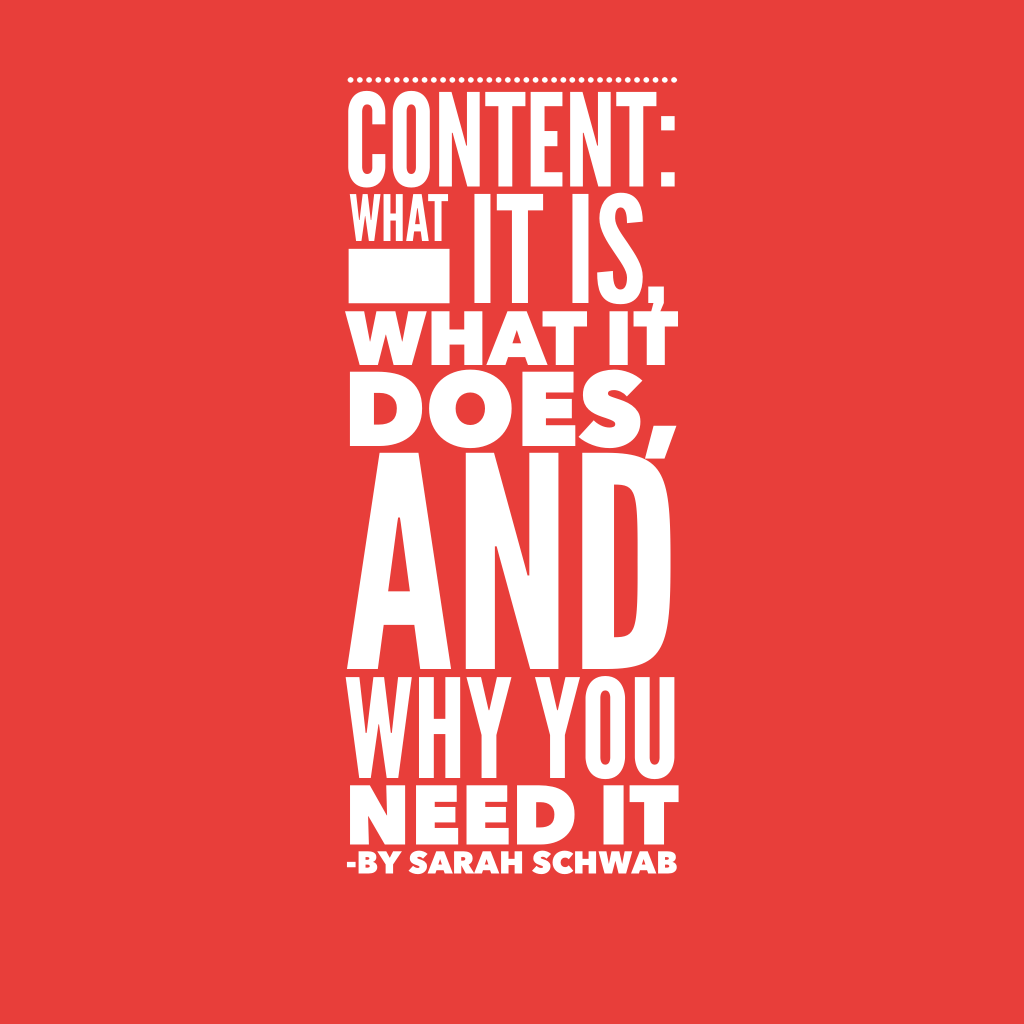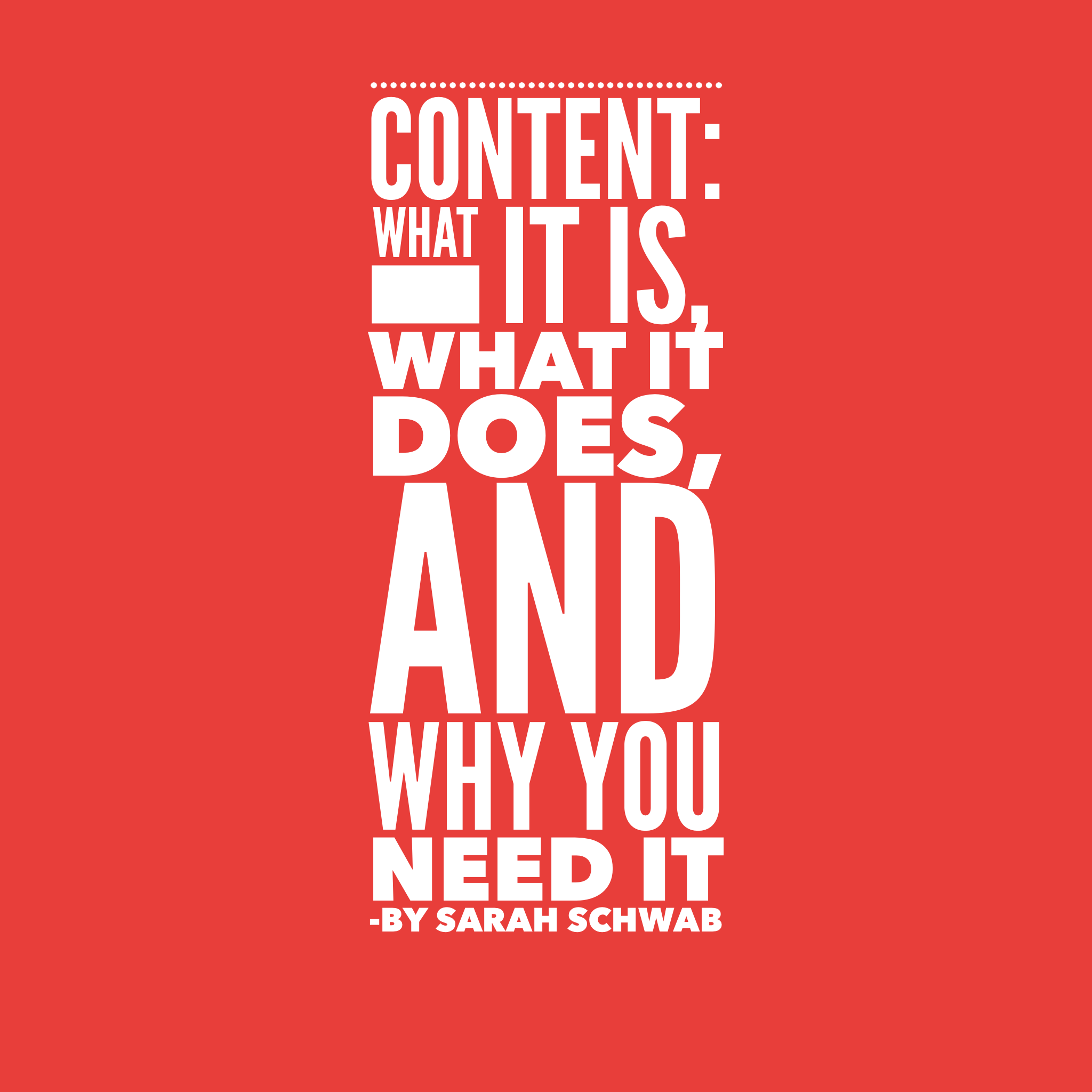Writers@Work: Content–What It Is, What It Does, and Why You Need It by Sarah Schwab
14 April 2015
Note From Rochelle
Dear Writers,
I’m delighted to welcome Sarah Schwab, the content creation coach, to the blog to explain what content is and why you need it. As a writer, you’ve no doubt been hearing a lot about content marketing. Whether you’re hoping to be hired to write content for a corporation or you just want to understand how you can use content to market your book, today’s article will help you. And if you want to learn more, you can join Sarah for a teleseminar tomorrow or in person in Milwaukee on Thursday for a class on why content is still king!
Happy Writing! Rochelle, the Write Now! Coach

Whether you are a writer, service provider, or entrepreneur, we all have the same goal – attract more readers, clients, or customers. We don’t live in a “build it and they will come” (or “write it and they will buy”) society. We must get the word out and attract people to us.
How do we do that?
The way I see it, there are only 4 functions for any marketing activity that support our goal:
1. Drive traffic
2. Capture leads
3. Nurture leads
4. Convert leads into customers
That’s it. That is the process. For every marketing activity you do, you should be able to identify which of those steps you are contributing toward. If you aren’t sure, it’s time to revisit your strategy.
Content Is 3 Out Of 4
Content plays a critical role in the first three steps in this process. Content marketing is such an incredible tool, and it is the cornerstone of effective online marketing. But it can seem very broad and unclear. It overlaps with many other forms of online marketing, which adds to the confusion. So what exactly qualifies as content marketing?
Well, it’s not as complicated as you might think. First of all, it requires the creation of content that aims to share value and build relationships with your prospective clients. Once you understand what content is and what forms it can take, content marketing is simply the umbrella for all the things you can do with that content.
There are many specific ways that you can use content, and that is where the overlapping and confusion comes in. It’s a little bit like when I was learning about shapes in elementary geometry. I was told that a square is a rectangle, but a rectangle isn’t necessarily a square. The rectangle has a broader definition, while the square is more specific.
In the same way, e-mail marketing can be a form of content marketing, but not all content marketing involves e-mail. Blogging is a form of content marketing, but not all content marketing is about writing a blog. SEO is significantly affected by content marketing, but not all content marketing is about SEO.
Because there are so many faces to content marketing, it can be difficult to know where to start. So, perhaps it is better to think about, not the specific uses for content, but the broader marketing purposes it can serve.
The ultimate purpose of content is to build relationships with the people who see it. But how you use the content determines what role it will play in your overall marketing plan.
In this sense, there are really only three purposes for content marketing: Drive traffic, capture leads, and nurture leads.
Drive Traffic
The first role that content plays is in increasing traffic to your website and your message. There are several ways you can use content to serve this purpose. First of all, having a significant amount of content on your site improves your rankings on the search engines. If you are using keywords in your content that people are searching for, your site and articles will show up in their results, driving them to your site.
Another way content can drive traffic is when you post it in other places where there is already a lot of traffic. Posting links to your content pieces on social media sites, popular blog sites, or other networks increases your reach and encourages people to visit your website. This could also happen in the form of partnerships during a launch or marketing campaign, when others encourage their followers to visit your site.
Capture Leads
The second thing that content can do is allow you to capture leads. This happens when you require people to opt-in in order to view your content. While this is a simple idea at its core, there are innumerable ways that you can execute it.
There are many different types of content that can be used for this purpose: e-books or white papers, videos, webinars, teleseminars and more. The opt-in can be something that lives on your website for a long period of time, or it can be part of a launch or shorter term marketing effort, using landing pages and other tools.
This is a critical component of content marketing. Capturing information from your leads is the only way to be able to communicate with your prospective customers and clients who find you online. If you don’t capture their e-mail address, they will disappear and you have no way of building a relationship with them.
These days, you must have a compelling piece of content for which people are willing to exchange their contact information. Not everyone will opt-in for the first thing you create either, so new opt-in campaigns should be built occasionally based on your overall marketing plan. This is where content marketing begins to overlap with e-mail marketing.
Nurture Leads
The final purpose of content marketing is to nurture leads. This is critically important as most people will not be ready to buy from you or hire you when they first encounter you. You need to establish trust and deepen your relationship with them, always moving them closer to the ultimate goal of becoming a paying customer.
This is typically done in the form of e-mail marketing. Sending your prospective customers, whose information you have captured, content pieces that they find helpful, interesting, and valuable. You can nurture leads in other ways as well, but using e-mail marketing in an authentic way is the most efficient and effective way to maintain a relationship with many people.
Hopefully this helps you to think more clearly about what content marketing is and how it can help you grow a business or market a book.
If you’d like to find out more, I’m doing a presentation called “Content Is STILL King.” You can attend the teleseminar, or if you happen to be near Milwaukee, Wisconsin, you can come and see it live. I’d love to have you there!
 About the author: Sarah Schwab is the Founder and President of Content Creation Coach. She helps small businesses and entrepreneurs to create consistent, compelling content they need to market their business online. She believes in the power of self-expression and creativity to transform her clients’ businesses and lives. Find out more about her approach to online marketing and content creation in her F.R.E.E. report: “Create Content That Connects: Three Mistakes That Are Making Your Content Fall Flat.” Get your report today and find more blog articles like this one at www.contentcreationcoach.com
About the author: Sarah Schwab is the Founder and President of Content Creation Coach. She helps small businesses and entrepreneurs to create consistent, compelling content they need to market their business online. She believes in the power of self-expression and creativity to transform her clients’ businesses and lives. Find out more about her approach to online marketing and content creation in her F.R.E.E. report: “Create Content That Connects: Three Mistakes That Are Making Your Content Fall Flat.” Get your report today and find more blog articles like this one at www.contentcreationcoach.com
Resources:
To learn more about content marketing writing, check out this post.
To learn more about writing to market your book, read this blog post.









